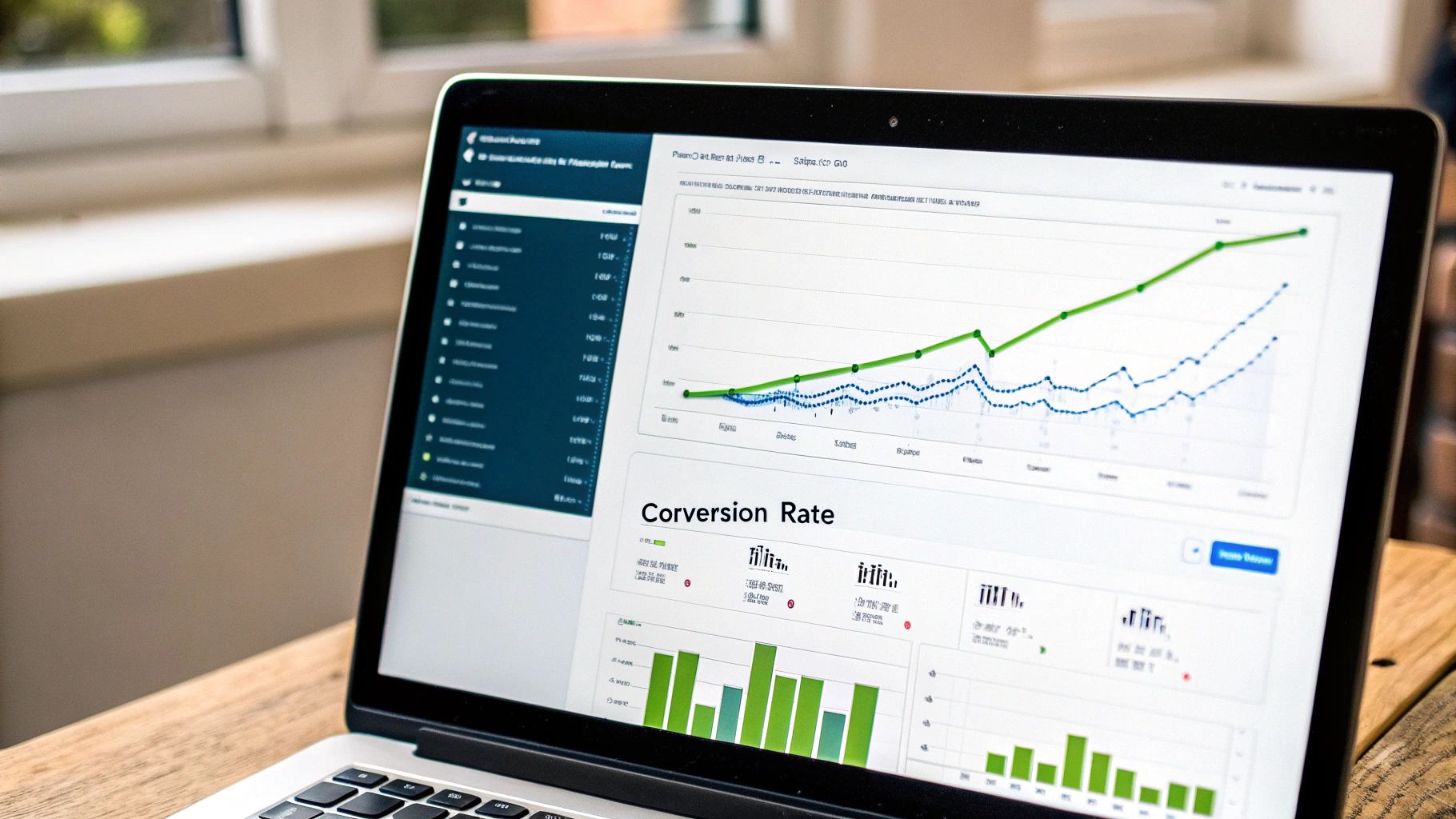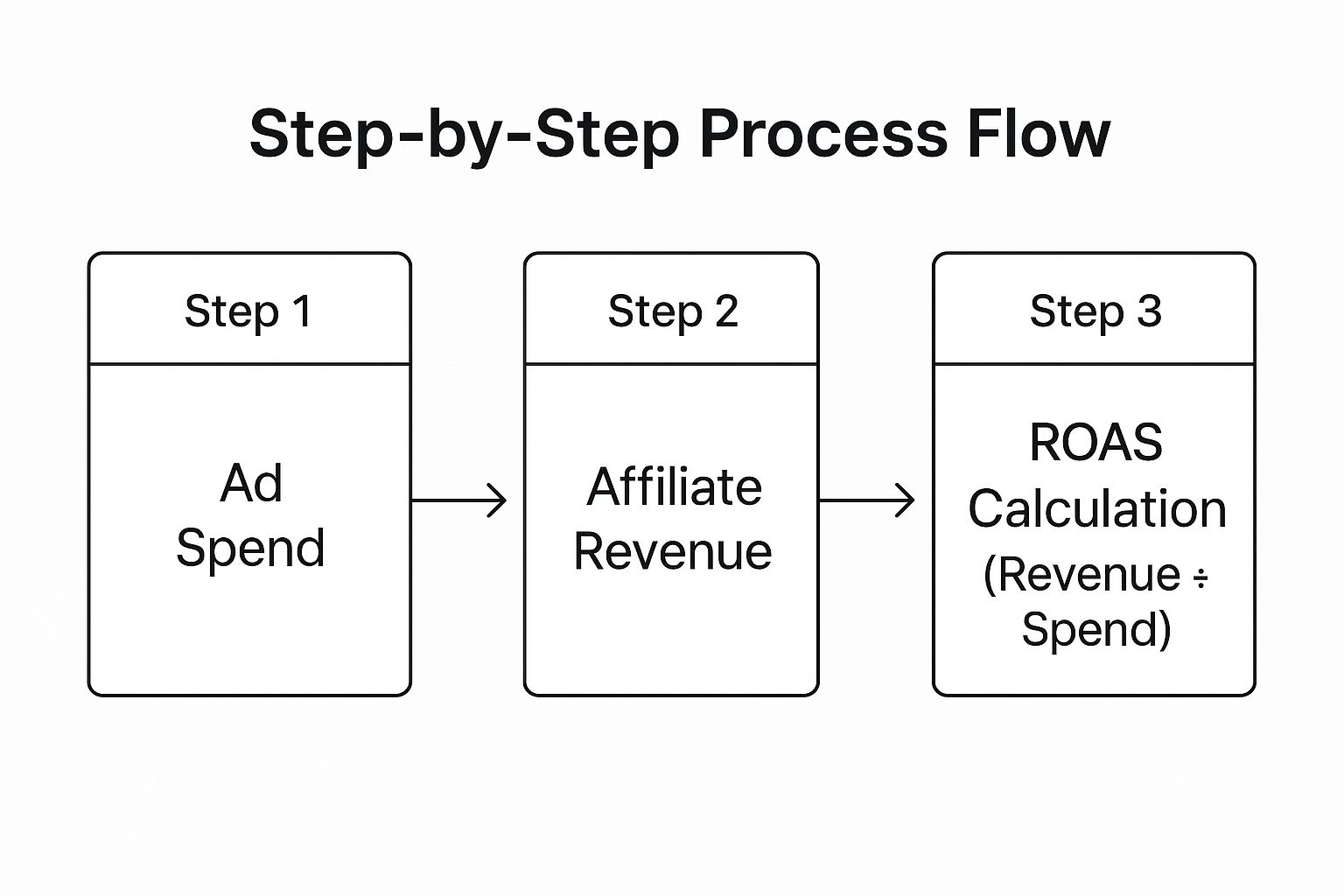Unlocking Affiliate Success: Measuring What Matters
Want to maximize your affiliate marketing ROI? This listicle reveals six crucial affiliate marketing metrics every startup and SaaS founder needs to track in 2025. From click-through rate (CTR) to customer lifetime value (CLV/LTV), understanding these metrics is key to optimizing campaigns, improving conversions, and ultimately, increasing revenue. Whether you're promoting your own SaaS product or using platforms like Refgrow, mastering these affiliate marketing metrics will drive sustainable growth. Let's get started!
1. Conversion Rate
Conversion rate is arguably the most crucial affiliate marketing metric. It represents the percentage of visitors who complete a desired action – a purchase, signup, free trial, or download – after clicking on your affiliate link. This metric provides a direct measure of how effectively your affiliate traffic translates into tangible results, making it a cornerstone of evaluating campaign success and a key indicator of your return on investment (ROI). Understanding and optimizing your conversion rate is essential for maximizing your affiliate marketing earnings. It tells you how well your chosen affiliate partners, promotional strategies, and target audience align with your product or service offering.

The conversion rate is calculated with a simple formula: (Conversions ÷ Clicks) × 100. For example, if an affiliate link receives 100 clicks and results in 5 sales, the conversion rate is 5%. This seemingly straightforward metric can be analyzed at different granularities – the campaign level, the individual product level, or across the entire portfolio of an affiliate partner. It's important to remember that conversion rates vary drastically across industries and are heavily influenced by the quality of the traffic being driven. For instance, a highly targeted campaign focused on a specific niche audience will likely yield a higher conversion rate than a broader, more generic campaign. Most affiliate platforms offer real-time tracking capabilities for conversion rates, providing up-to-the-minute insights into performance. Learn more about Conversion Rate to understand its intricacies.
This metric’s position at the top of the list of essential affiliate marketing metrics is justified by its direct link to revenue generation. For early-stage startups, self-serve SaaS companies, and product-led growth SaaS, tracking conversion rates is especially critical. In these often resource-constrained environments, understanding what drives conversions allows founders and indie hackers to focus their efforts and budget on the most effective strategies.
Pros of Tracking Conversion Rate:
- Direct Indicator of Traffic Quality and Relevance: A high conversion rate suggests that the traffic being directed to your site is highly relevant and interested in your offering.
- Identifies High-Performing Content and Channels: Analyzing conversion rates across different affiliate partners, content pieces, and marketing channels allows you to pinpoint what resonates best with your target audience and drives the most conversions.
- Easy to Understand and Communicate: The simplicity of the conversion rate metric makes it easy to understand and communicate to stakeholders, facilitating clear reporting and data-driven decision-making.
- Enables Quick Optimization Decisions: Real-time tracking allows for swift adjustments to underperforming campaigns or the reallocation of resources to more successful strategies.
Cons of Relying Solely on Conversion Rate:
- Misleading without Traffic Volume: A high conversion rate with low traffic volume might not generate significant revenue. Volume is a critical companion metric to conversion rate.
- May Not Account for Longer Sales Cycles: For products or services with longer sales cycles, the initial conversion rate might not reflect the full impact of affiliate efforts. Attribution and multi-touch attribution models can help provide a more complete picture.
- Doesn't Reflect Customer Lifetime Value: Conversion rate focuses on the initial transaction and doesn't inherently capture the long-term value of a customer acquired through affiliate channels.
- Can Fluctuate Due to External Factors: External factors like seasonality, market trends, and competitor activities can influence conversion rates, making it important to consider the broader context.
Examples of Conversion Rates:
- Amazon Associates: Typically see conversion rates between 1-3% due to the vast product catalog and diverse customer base.
- SaaS Affiliate Programs: Often achieve higher conversion rates, ranging from 5-15%, reflecting a more targeted audience and higher-value offerings.
- High-Ticket Items: May have lower conversion rates (0.5-2%) but compensate with significantly higher commission values per conversion.
Tips for Optimizing Conversion Rates:
- Focus on Relevant, Targeted Traffic: Prioritize quality over quantity. Partner with affiliates who cater to your specific niche and target audience.
- Test Different Landing Pages and Promotional Methods: A/B test different landing pages and promotional creatives to identify what resonates best with your target audience and drives the highest conversions.
- Track Conversion Rates by Traffic Source: Segment your conversion rate data by traffic source (e.g., specific affiliate partners, social media platforms) to identify your most effective channels and optimize accordingly.
- Consider Seasonal Trends and Adjust Expectations: Be aware of seasonal fluctuations in buying behavior and adjust your expectations and strategies accordingly. For example, conversion rates for certain products might spike during holidays or specific shopping seasons.
2. Earnings Per Click (EPC)
Earnings Per Click (EPC) is a crucial affiliate marketing metric that measures the average commission earned for every click generated to a merchant's website through your affiliate link. It provides a holistic view of your affiliate link's profitability by combining two key factors: conversion rate (the percentage of clicks that result in a sale) and commission value (the amount earned per sale). This creates a single, actionable metric that directly correlates to your revenue potential. Understanding and utilizing EPC effectively is vital for optimizing your affiliate marketing campaigns and maximizing your earnings.

EPC is calculated by dividing your total earnings from an affiliate program by the total number of clicks generated to the merchant's website through your affiliate link. This simple formula – Total Earnings ÷ Total Clicks – normalizes performance across different commission structures, allowing you to compare the profitability of various affiliate programs, even if they offer different commission percentages or flat-rate payouts. Moreover, EPC updates in real-time as commissions are earned, providing you with a dynamic view of your link's performance. This real-time feedback is invaluable for quickly identifying what's working and what's not. You can further refine your analysis by segmenting EPC data by time period, specific product, or individual campaign, allowing for granular insights into your performance.
For early-stage startups, self-serve SaaS companies, and product-led growth SaaS, EPC is particularly valuable because it offers a clear and concise way to measure the effectiveness of affiliate marketing efforts. For SaaS founders and indie hackers, often working with limited resources, focusing on EPC can help prioritize promotional efforts towards the most lucrative partnerships. Imagine you're promoting two different SaaS products: one with a high commission rate but low conversion rate, and another with a lower commission rate but a high conversion rate. EPC helps you quickly determine which product generates more revenue per click, allowing you to allocate your marketing efforts strategically.
Key features of EPC:
- Calculated as: Total Earnings ÷ Total Clicks
- Normalization: Compares performance across varying commission structures.
- Real-time Updates: Provides immediate feedback on performance.
- Segmentation: Allows analysis by time period, product, or campaign.
Pros of using EPC:
- Single Metric for Profitability: Captures the overall profitability of an affiliate link.
- Direct Comparison: Enables easy comparison between different affiliate programs.
- Prioritization: Helps prioritize promotional efforts based on revenue potential.
- Holistic View: Accounts for both conversion rate and commission value.
Cons of using EPC:
- Skewed by High-Value Sales: Occasional high-value sales can inflate EPC, making it appear higher than usual.
- May Not Reflect Consistency: Doesn't always reflect long-term, consistent performance.
- Ignores Acquisition Costs: Doesn't account for the costs associated with acquiring traffic.
- Misleading with Small Samples: Can be unreliable with limited data or small sample sizes.
Examples of EPC in action:
- ShareASale: Prominently displays EPC for each merchant, making it easy for affiliates to compare opportunities.
- ClickBank: Shows a 3-month average EPC to provide a more stable performance indicator for product selection.
- Commission Junction (CJ Affiliate): Offers detailed EPC breakdowns by time period, allowing for in-depth performance analysis.
Tips for using EPC effectively:
- Focus on Trends: Look for consistent EPC trends over time rather than focusing on single high values.
- Compare within Categories: Compare EPC across similar product categories for a more accurate assessment.
- Factor in Costs: Consider your traffic acquisition costs (e.g., advertising spend) when evaluating EPC profitability.
- Test and Optimize: Experiment with different promotional strategies (e.g., content marketing, social media advertising) to improve your EPC over time.
By understanding EPC and using it in conjunction with other key metrics, you can significantly enhance your affiliate marketing efforts, optimize your campaigns, and ultimately maximize your earning potential. Remember to always analyze EPC in the context of your overall marketing strategy and consider the specific nuances of each affiliate program you're involved in.
3. Return on Advertising Spend (ROAS)
Return on Advertising Spend (ROAS) is a critical affiliate marketing metric for those utilizing paid advertising to drive traffic and sales. It measures the effectiveness of your paid campaigns by calculating how much revenue you generate for every dollar spent on advertising. Understanding and optimizing your ROAS is essential for profitable and scalable affiliate marketing, particularly for early-stage startups, self-serve SaaS companies, product-led growth SaaS, SaaS founders, and indie hackers looking to maximize their marketing budget. This metric deserves a place on this list because it provides a direct link between your advertising investment and the return you receive, enabling data-driven decisions for budget allocation and campaign optimization.
ROAS is calculated by dividing your affiliate revenue by your advertising spend. It can be expressed as a ratio (e.g., 3:1, meaning $3 of revenue for every $1 spent) or a percentage (e.g., 300%, also indicating $3 earned per $1 spent). One of the key features of ROAS is its flexibility. You can track it at different levels of granularity, such as the campaign level, ad group level, or even down to the individual keyword level. This allows for precise identification of what's working and what's not. Many advertising platforms, including Google Ads and Facebook Business Manager, offer integrated ROAS tracking, automating the process and providing real-time insights.
A strong ROAS indicates a profitable advertising strategy. For example, a successful Facebook Ad campaign might generate a 5:1 ROAS, meaning $5 in revenue for every $1 spent. Similarly, a Google Ads campaign with a 300% ROAS indicates $3 earned per $1 spent. Even in niche markets like financial product promotions, a well-executed native advertising campaign could achieve a 250% ROAS.
The following infographic visualizes the process of calculating ROAS, breaking it down into three key steps: Ad Spend, Affiliate Revenue, and the ROAS Calculation itself.

The infographic clearly demonstrates the sequential relationship between ad spend and affiliate revenue, leading to the final ROAS calculation. As shown, ROAS is derived directly from the relationship between revenue and spending.
Pros of Tracking ROAS:
- Clear Profitability Indicator: Provides a direct measure of the profitability of your paid campaigns.
- Budget Allocation Optimization: Enables data-driven decisions on where to allocate your advertising budget for maximum return.
- Identifies Profitable Traffic Sources: Helps pinpoint the most effective advertising platforms and campaigns.
- Essential for Scaling: A healthy ROAS is crucial for scaling paid affiliate campaigns sustainably.
Cons of Relying Solely on ROAS:
- Limited Scope: Only relevant for affiliates using paid advertising, excluding organic or other marketing efforts.
- Incomplete Picture: Doesn't account for time investment, content creation costs, or other associated expenses.
- Attribution Window Dependency: Can be affected by the attribution window settings within your advertising platform.
- Short-Term Focus: May not capture the long-term customer value, especially for subscription-based products.
Tips for Optimizing ROAS:
- Target a Minimum 3:1 ROAS: This generally covers advertising costs and other business expenses, aiming for actual profitability.
- Granular Tracking: Track ROAS at the campaign, ad group, and keyword levels to identify top performers and areas for improvement.
- Consider Lifetime Value: When setting ROAS targets, consider the long-term value of a customer, especially for recurring revenue models.
- Test Attribution Windows: Experiment with different attribution window settings to optimize tracking and find the most accurate reflection of your campaign performance.
Learn more about Return on Advertising Spend (ROAS)
By understanding and effectively utilizing ROAS, affiliate marketers can significantly improve their paid campaign performance, driving revenue growth and maximizing their return on investment. For those starting out or looking to scale their efforts, ROAS is an invaluable metric for building a sustainable and profitable affiliate marketing business.
4. Customer Lifetime Value (CLV/LTV)
Customer Lifetime Value (CLV or LTV) is arguably the most crucial affiliate marketing metric for understanding the long-term profitability of your partnerships. While other metrics like click-through rates and conversion rates offer valuable snapshots of performance, CLV provides a holistic view of the total revenue generated by a single customer referred through your affiliate program. This makes it an essential metric, particularly for SaaS founders, indie hackers, and startups focusing on product-led growth with recurring revenue models. Focusing on CLV moves beyond short-term gains and emphasizes building sustainable, profitable affiliate relationships.
In essence, CLV answers the question: How much revenue can I expect from a single customer brought in by an affiliate over the entire duration of their relationship with my product or service? This metric is particularly valuable for recurring commission programs, subscription services, and any business model where customers are expected to make repeat purchases. By understanding CLV, you can accurately assess the long-term value of your promotional efforts and make informed decisions about customer acquisition costs and affiliate commissions.
CLV is typically calculated using the following formula:
Average Order Value × Purchase Frequency × Customer Lifespan × Commission Rate = CLV
Let's break down each component:
- Average Order Value: The average amount a customer spends per transaction.
- Purchase Frequency: How often a customer makes a purchase within a given timeframe (e.g., monthly, annually).
- Customer Lifespan: The average length of time a customer remains a paying subscriber or active purchaser.
- Commission Rate: The percentage of each sale or recurring payment paid to the affiliate.
Examples of CLV in Action:
- SaaS: Imagine your SaaS product has a monthly subscription of $50 and you offer affiliates a recurring 20% commission. If the average customer lifespan is 18 months, your CLV is $50 x 0.20 x 18 = $180 per customer.
- E-commerce: An e-commerce store selling beauty products might have an average order value of $75, with customers making an average of two purchases per year and an average customer lifespan of 3 years. If the affiliate commission is 10%, the CLV is $75 x 2 x 3 x 0.10 = $45.
- Subscription Box: A monthly subscription box costing $25 with a 15% affiliate commission and an average customer lifespan of 6 months yields a CLV of $25 x 0.15 x 6 = $22.50.
Pros of Using CLV:
- Long-term perspective: Provides a true understanding of the long-term revenue potential of each customer.
- Justified acquisition costs: Enables you to justify higher customer acquisition costs for high-LTV customers.
- Prioritization: Helps prioritize high-retention products, services, and merchants.
- Essential for recurring revenue: Absolutely crucial for subscription and SaaS affiliate programs.
Cons of Using CLV:
- Complex calculation: Can be challenging to calculate accurately, especially without sufficient historical data.
- Data dependency: Requires extensive historical data on customer behavior.
- Prediction difficulty: Difficult to predict for new programs or products without established customer lifespans.
- Limited relevance for one-time purchases: May not be as relevant for products with a single purchase cycle.
Tips for Leveraging CLV in Your Affiliate Marketing Strategy:
- Focus on recurring revenue: Concentrate on LTV when working with subscription and recurring commission programs.
- Track retention: Diligently track customer retention rates to refine and improve your CLV calculations.
- Compare to acquisition costs: Compare LTV to customer acquisition cost (CAC) to understand the profitability of your affiliate campaigns. Learn more about Customer Lifetime Value (CLV/LTV)
- Segment by traffic source: Segment LTV by traffic source (e.g., specific affiliates, social media platforms) to pinpoint your highest-value channels.
By understanding and actively utilizing CLV, early-stage startups, self-serve SaaS companies, and product-led growth SaaS businesses can build more sustainable and profitable affiliate marketing programs, driving long-term growth and maximizing the return on their investment in affiliate partnerships. This metric allows you to prioritize high-value customers, optimize your marketing spend, and foster stronger relationships with your affiliate partners.
5. Click-Through Rate (CTR)
Click-Through Rate (CTR) is a pivotal affiliate marketing metric that measures the percentage of people who click on an affiliate link after seeing it. It provides crucial insights into the effectiveness of your affiliate content, the strategic placement of your links, and the resonance of your promotional messaging. CTR is fundamental to understanding how well your content captures your audience's attention and drives initial engagement with the promoted products or services. Essentially, it’s the first step in the conversion funnel and a strong indicator of whether your audience finds your recommendations valuable.

CTR is calculated using a simple formula: (clicks ÷ impressions) × 100. For example, if an affiliate link receives 50 clicks out of 1000 impressions, the CTR is 5%. This metric can be tracked across different content types (blog posts, social media updates, email newsletters) and placements (banner ads, in-text links, call-to-action buttons). It's important to remember that CTR varies considerably based on the platform, the specific audience you're targeting, and the promotional method employed. Fortunately, most affiliate platforms offer real-time tracking of CTR, allowing you to monitor performance and make adjustments as needed.
For early-stage startups, self-serve SaaS companies, and product-led growth SaaS, understanding and optimizing CTR is paramount for driving user acquisition through affiliate channels. A high CTR suggests that your marketing message resonates with your target audience and that your affiliate links are strategically placed within engaging content. This metric allows SaaS founders and indie hackers to quickly assess the effectiveness of different campaigns and make data-driven decisions to improve performance.
Examples of Successful Implementation:
Targeted Email Campaign: A SaaS company promoting a new project management tool through an email campaign to project managers achieves a 4% CTR, significantly exceeding the typical 2-5% benchmark for affiliate email marketing. This success is attributed to highly targeted audience segmentation and a compelling email subject line.
Contextual In-Text Links: A blog post reviewing various marketing automation platforms incorporates affiliate links within the context of the review, achieving a 2.5% CTR, higher than the average 1-3% for blog post affiliate links. The seamless integration of the links within valuable content contributed to the higher click-through rate.
Influencer Marketing on Social Media: A SaaS founder partners with a relevant influencer on Twitter to promote their latest product update. By leveraging the influencer's established audience and crafting engaging tweets with clear call-to-actions, the campaign achieves a 1.8% CTR, exceeding the typical 0.5-2% range for social media.
Actionable Tips for Improving CTR:
A/B Test Call-to-Actions: Experiment with different call-to-action phrases and button designs to identify what resonates best with your audience. For example, compare “Learn More” with “Get Started Today” or test different button colors and sizes.
Strategic Link Placement: Integrate affiliate links naturally within valuable content, ensuring they are relevant to the surrounding information. Avoid overwhelming the reader with excessive links. Instead, focus on quality over quantity.
Compelling and Honest Promotion: Use persuasive language that highlights the benefits of the product or service you're promoting while maintaining transparency and honesty. Build trust with your audience by providing genuine recommendations.
Track CTR by Placement: Monitor CTR for different link placements to identify optimal positions within your content. For instance, links placed within the first few paragraphs of a blog post or within a prominent call-to-action section might perform better than links buried deep within the content.
Pros and Cons of Using CTR:
Pros:
- Early indicator of content effectiveness
- Helps optimize placement and messaging
- Easy to A/B test and improve
- Directly impacts overall affiliate performance
Cons:
- High CTR doesn't guarantee conversions
- Can be manipulated through misleading tactics
- Varies significantly by platform and audience
- May not reflect true engagement quality
CTR deserves its place in the list of essential affiliate marketing metrics because it provides a foundational understanding of how well your promotional efforts are capturing audience attention and driving initial engagement. While a high CTR doesn't guarantee sales, it is a crucial first step in the conversion process and an excellent indicator of the effectiveness of your content, messaging, and link placement strategies. By continuously monitoring and optimizing your CTR, you can significantly improve the overall performance of your affiliate marketing campaigns and drive more valuable traffic to your partners.
6. Revenue Per Visitor (RPV)
Revenue Per Visitor (RPV) is a crucial affiliate marketing metric that measures the average revenue generated for every visitor who interacts with your affiliate content. Unlike metrics that focus on isolated aspects of the affiliate marketing funnel, RPV provides a holistic view of your performance by combining traffic volume, conversion rate, and average order value into a single, comprehensive profitability metric. Understanding and optimizing your RPV is essential for maximizing your earnings and making data-driven decisions about your affiliate marketing strategy. This metric is particularly valuable for early-stage startups, self-serve SaaS companies, product-led growth SaaS, SaaS founders, and indie hackers looking to effectively measure and scale their affiliate programs.
RPV goes beyond simply measuring clicks or conversions; it tells you the true monetary value of each visitor. This allows you to evaluate the overall effectiveness of your affiliate efforts and optimize for maximum profitability. Instead of chasing vanity metrics like high click-through rates that don't necessarily translate into sales, focusing on RPV encourages you to build a strategy that attracts high-quality traffic likely to convert and generate revenue.
How RPV Works:
The calculation for RPV is straightforward:
RPV = Total Affiliate Revenue / Total Visitors
For example, if your affiliate marketing efforts generated $5,000 in revenue from 2,000 visitors, your RPV would be $2.50. This means each visitor, on average, contributed $2.50 to your earnings.
Why RPV Deserves Its Place in the List:
RPV stands out among other affiliate marketing metrics due to its comprehensive nature. While metrics like click-through rate (CTR) and conversion rate provide valuable insights into specific stages of the funnel, they don't paint the full picture of profitability. RPV, however, encompasses the entire conversion funnel, from initial click to final purchase, offering a more accurate representation of your overall success.
Features and Benefits of Tracking RPV:
Encompasses Entire Conversion Funnel Performance: RPV provides a holistic overview of your entire affiliate marketing funnel, revealing how effectively you're converting visitors into paying customers.
Trackable by Different Segments: You can segment RPV by traffic source (e.g., social media, email marketing, paid ads), content type (e.g., blog posts, videos, social media stories), or time period, enabling granular analysis and optimization.
Normalizes Performance Across Different Audience Sizes: RPV allows you to compare the performance of different campaigns or traffic sources, even if they have vastly different audience sizes. This normalization provides a level playing field for evaluating effectiveness.
Holistic View of Overall Performance: RPV provides a clear and concise metric to gauge the overall health and profitability of your affiliate marketing efforts.
Enables Comparison Across Different Traffic Sources: By segmenting RPV by traffic source, you can identify which channels are driving the most valuable traffic and allocate your budget accordingly.
Pros and Cons of Using RPV:
Pros:
- Holistic performance overview
- Cross-channel comparison
- Revenue-focused optimization
- Strategic budget allocation
Cons:
- Can mask issues with individual funnel components
- Requires significant traffic volume for reliable data
- Doesn't always account for traffic quality differences
- Can be affected by seasonal or external factors
Examples of Successful RPV Implementation:
A tech review blog generating $2.50 RPV from 10,000 monthly visitors demonstrates effective monetization of a large audience.
A finance newsletter achieving $8.00 RPV from a targeted subscriber base highlights the value of focusing on a niche audience with high purchase intent.
A lifestyle Instagram account earning $1.20 RPV from story link clicks shows how even micro-conversions can contribute to overall revenue.
Actionable Tips for Improving RPV:
Prioritize RPV over Traffic Alone: Focus on attracting high-quality traffic that's likely to convert, rather than simply maximizing visitor numbers.
Segment by Traffic Source: Identify your most valuable traffic channels by analyzing RPV for each source. Double down on what works and refine underperforming channels.
Test Different Content Types: Experiment with various content formats (e.g., blog posts, videos, infographics) to determine which resonates best with your audience and drives higher RPV.
Factor in Traffic Costs: If you're using paid advertising, consider the cost of acquiring each visitor when evaluating RPV profitability. Ensure your revenue generated outweighs your advertising spend.
By understanding and actively optimizing your RPV, you can transform your affiliate marketing efforts from a series of disjointed activities into a cohesive, revenue-generating machine. This holistic approach allows you to make data-driven decisions, allocate your budget effectively, and ultimately maximize your earnings.
Affiliate Marketing Metrics Overview
| Metric | Implementation Complexity 🔄 | Resource Requirements ⚡ | Expected Outcomes 📊 | Ideal Use Cases 💡 | Key Advantages ⭐ |
|---|---|---|---|---|---|
| Conversion Rate | Low - simple ratio calculation, real-time tracking | Low - requires click and conversion data | Measures traffic-to-action effectiveness | Performance optimization, quick decision making | Direct indicator of traffic quality and relevance |
| Earnings Per Click (EPC) | Medium - combines earnings and clicks, needs commission data | Medium - requires earnings tracking | Assesses profitability per click | Comparing programs, prioritizing promotions | Captures overall profitability in single metric |
| Return on Advertising Spend (ROAS) | Medium - needs accurate ad spend and revenue tie-ins | High - integrates with ad platforms | Shows paid campaign profitability | Paid traffic campaigns, budget allocation | Clear profitability metric for ad investments |
| Customer Lifetime Value (CLV/LTV) | High - complex, needs historical sales and retention data | High - requires data over time | Indicates long-term revenue potential | Recurring commissions, SaaS, subscription models | Provides long-term value perspective |
| Click-Through Rate (CTR) | Low - ratio of clicks to impressions | Low - impression and click tracking | Measures initial engagement effectiveness | Content optimization, A/B testing messaging | Early indicator of content effectiveness |
| Revenue Per Visitor (RPV) | Medium - combines total revenue and visitors | Medium - tracking of visitor and revenue data | Holistic view of traffic profitability | Portfolio optimization, traffic source evaluation | Normalizes performance across traffic volumes |
Level Up Your Affiliate Game with Refgrow
Mastering affiliate marketing metrics is essential for any successful program. From conversion rates and earnings per click (EPC) to return on ad spend (ROAS) and customer lifetime value (CLV/LTV), understanding these key performance indicators (KPIs) provides invaluable insights into your program's effectiveness. Knowing your click-through rate (CTR) and revenue per visitor (RPV) allows you to fine-tune your strategies, optimize campaigns, and ultimately drive more revenue. By analyzing these metrics, you can identify top-performing affiliates, understand which strategies resonate with your audience, and make data-driven decisions to maximize your return on investment. This granular level of control empowers you to scale your affiliate program efficiently and effectively.
These insights translate directly to improved profitability and sustainable growth, especially crucial for early-stage startups, self-serve SaaS companies, product-led growth SaaS, and indie hackers. A data-driven approach to affiliate marketing unlocks the potential of this powerful channel, allowing you to expand your reach, acquire new customers, and boost your bottom line. Don't just rely on guesswork; leverage the power of affiliate marketing metrics to drive your business forward.
Ready to streamline your affiliate program and unlock its full potential? Refgrow makes tracking these crucial affiliate marketing metrics effortless, allowing you to focus on what you do best. Visit Refgrow today and discover how we can help you scale your referral-based growth.

